You want to have a toolkit handy to treat everyday illnesses such as a sore throat, cough, cold, flu, headaches, skin irritations, and stomach bugs that come along from time to time, especially when you do not have access to your doctor or chemist.
Fortunately, nature provides us with many replacements for allopathic and prescription drugs. You can buy some of them from your pharmacist or health food store now, select others from your kitchen cupboard, or gather them from your herb garden or natural surroundings.
Being prepared by keeping natural remedies in your medicine cabinet to treat the ailments caused by viruses and bacteria is the best option.
Talk to your doctor about adding herbal treatments to your current medications and when you are pregnant or breastfeeding. Studies show that overusing and long-term consumption of any substance may cause side effects, while some may have the desired results for a family member but not for you.
Natural Cold, Sore Throat, and Cough Remedies
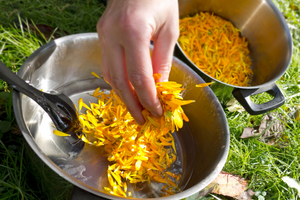 Pelargonium or geraniums, elderberry syrup, and echinacea or coneflowers reduce the symptoms and shorten the duration of colds. We suggest you try them to see which one works best for you rather than using them together.
Pelargonium or geraniums, elderberry syrup, and echinacea or coneflowers reduce the symptoms and shorten the duration of colds. We suggest you try them to see which one works best for you rather than using them together.
Related: How to Use Herbs and Make Your Own Cold Medicines at Home
Some natural cough and cold remedies contain pelargonium that shortens the severity and timespan of the discomfort, while elderberry syrup has antiviral properties to relieve flu and colds.
Echinacea fights various bacterial infections and is available as pills, drops, and teas. It may lessen cold symptoms, strep throat, toxic shock syndrome, and flesh-eating disease if you start taking it as soon as the warning signs appear.
Soothe a sore throat or cough with a spoon of antibacterial honey or stir it into a comforting cup of tea containing slippery elm or licorice. Both have coating properties and reduce irritation.
Honey draws out infection and heals wounds. It treats about 60 types of bacteria, including methicillin-resistant Staphylococcus aureus, that can cause joint, bone, bloodstream, skin, soft tissue infections, and pneumonia.
Digestive Problems, Nausea, and Upset Stomach
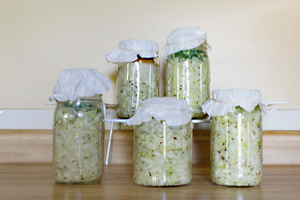 Probiotics are live, gut-friendly yeasts and bacteria that have several health benefits.
Probiotics are live, gut-friendly yeasts and bacteria that have several health benefits.
Related: How To Make Sauerkraut – The Most Effective Probiotic
Doctors prescribe them to alleviate the problems caused by antibiotics.
They also treat diarrhea resulting from an infection.
Raw sauerkraut, dark chocolate, pickles, olives, raw cheese, kimchi, kombucha, miso paste, and yogurt are excellent substitutes if you do not have a pre-packaged supplement available.
Ginger is a natural antibiotic that is also helpful against motion sickness and nausea. Look for a medicinal brand tea or try candied ginger when traveling.
Topical Creams for Skin Irritations and Soreness
Tea tree oil is an anti-inflammatory that relieves fungus and bacterial infections, so you can apply it to treat athlete’s foot and acne.
Arnica cream eases bruising, aching and painful muscles.
Calendula alleviates skin irritations such as diaper rash and eczema.
Natural Remedies for Anxiety and Insomnia
 You need not necessarily take an oral antidote against anxiety.
You need not necessarily take an oral antidote against anxiety.
Relaxation techniques can comfort and help you cope. Deep, slow breathing with an open chest, calming thoughts, and planning may do the trick. Take the time to inhale for four seconds and exhale for six to calm the nervous system.
Listen to relaxing music while shifting your focus from one thing to the next.
Anxiety and sleeplessness remedies include valerian, passionflower, chamomile tea, lavender aromatherapy oil, and lemon balm. Many people find Rescue Remedy®, containing five Bach flowers, to relieve acute stress. You can buy it over the counter from most health outlets.
Natural Antibiotics
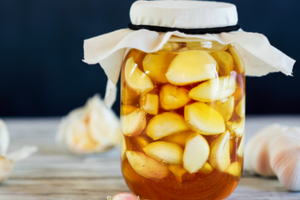 It is vital to know which natural antibacterial substances are safe to use and when, especially if you are allergic to penicillin, antibiotics harm your digestive system, or circumstances prevent you from getting to your doctor or chemist.
It is vital to know which natural antibacterial substances are safe to use and when, especially if you are allergic to penicillin, antibiotics harm your digestive system, or circumstances prevent you from getting to your doctor or chemist.
Related: Homemade Fermented Honey Garlic
Garlic is safe and can be effective against multi-drug resistant tuberculosis, E. coli, salmonella, and other forms of bacteria.
Goldenseal, orangeroot or yellow puccoon from the buttercup family is available in capsule and tea form. Use it to combat respiratory problems, digestive disorders, skin and urinary tract infections. It is not safe for infants, pregnant, and breastfeeding women.
Soak antifungal, antiviral cloves in water to fight bacteria, including E. coli that causes digestive disorders, and keep the spice or gel on hand to fight toothache. Oregano oil could boost the immune system and has anti-inflammatory, antioxidant, and natural antibiotic properties.
Pain Relief
 There are several natural options for obtaining pain relief. These include essential oils. They are toxic if swallowed, so you should not ingest them. Inhale or apply them to your skin diluted with a carrier oil. Add three to five drops of essential oil to an ounce of sunflower, evening primrose, olive, or jojoba carrier oil.
There are several natural options for obtaining pain relief. These include essential oils. They are toxic if swallowed, so you should not ingest them. Inhale or apply them to your skin diluted with a carrier oil. Add three to five drops of essential oil to an ounce of sunflower, evening primrose, olive, or jojoba carrier oil.
Lavender essential oil may relieve anxiety, sleeplessness, headaches, and pain.
Rosemary could relax muscles and reduce soreness, inflammation, seizures, and headaches.
Studies suggest that peppermint essential oil has pain-relieving, antimicrobial, and anti-inflammatory properties for topical arthritis and muscle spasm treatment. Rub it on your forehead and temples to ease a tension headache but do not use it near children or apply it to broken skin.
Eucalyptus might reduce inflammation, swelling, and tenderness. You can inhale it to ease discomfort after an operation. Remove kids and pets from the room first and do a spot check on your skin to ensure you do not have an adverse reaction.
Add turmeric to juices, smoothies, and curry dishes, or take it for four weeks to reduce inflammation and manage osteoarthritis pain. Many pain-relieving products, topical creams, and patches contain capsaicin, an ingredient in chili peppers. It mutes the pain signals carried by nerves.
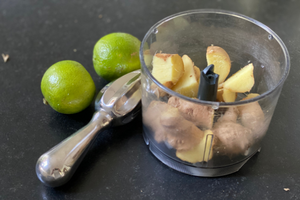 Eat two grams of raw ginger daily for five days to reduce inflammation in overworked muscles. You may want to add it to tea or a smoothie instead.
Eat two grams of raw ginger daily for five days to reduce inflammation in overworked muscles. You may want to add it to tea or a smoothie instead.
Feverfew is a medicinal plant traditionally used to treat toothaches, rheumatoid arthritis, stomach aches, muscle spasms, fever, and boost breast milk supply. It may also prevent migraines.
Talk to your physician before harnessing its analgesic or pain-relieving attributes as it may cause disagreeable aftereffects in some.
When Do Natural Remedies Come in Handy?
You want a backup plan if you are cut off from access to healthcare or worried about the escalation of drug-resistant bacteria. Consider growing a medicinal herb garden at home or stock up on and store effective remedies.
You may even find helpful medicines growing in vacant lots or through cracks in the sidewalk. Besides being freely available, natural medicine is also sustainable, easy to learn about, belongs to everyone, can be used as a barter item, and can help you heal.
You may also like:
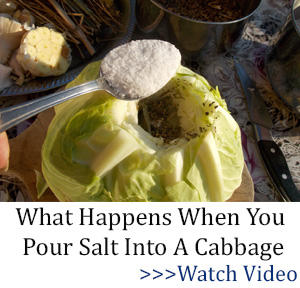 Did You Pass On These Skills To Your Sons When They Were Young?
Did You Pass On These Skills To Your Sons When They Were Young?
10 Medical Supplies You Need To Stockpile Before It’s Too Late (Video)
How To Deal With Neighbors And Friends That Come Begging For Food At Your Door In A Crisis
Does Ammo Expire? This Man Fired His 60 Year Old Ammo And This Is What Happened

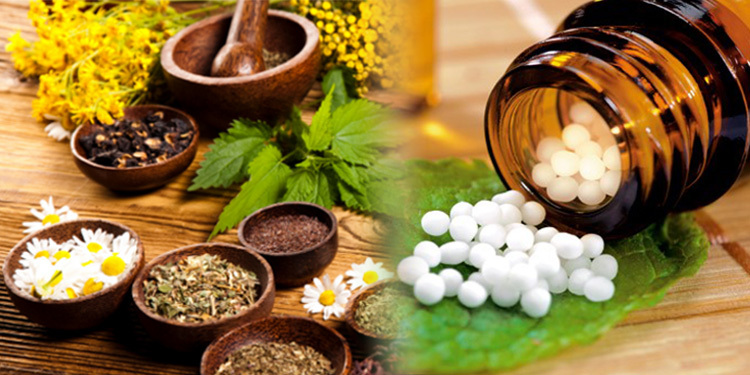













Thank you. Well written with an abundance of advice. I might add the protective and healing benefits of vitamin D from moderate UV exposure to the sun, as well as exposure to early morning infrared light from the sun. Humans benefit from probiotic soil-borne organisms as well, specifically those colonized around the roots of plants. Garden in the morning sun and don’t wash your hands too often.
It’s why we did a small separate garden for little things like this
That’s cool! Most of ours grows as a wild garden. The front yard is a ‘flower bed’ of native medicinal and landrace plants. And, of course, food is medicine. Do you raise calendula? The petals are eatable and used as a cream are very antibacterial. niio
Food is not medicine, food is food. Medicine is altogether different. Honestly as a nutritionist I’m sick of hearing that food is medicine. No, it isn’t. Otherwise no one would die of Cancer, Aids, or even TB.
Food can bring health benefits, but it is NOT medicine.
well i would say Elohim put out the way you should eat food. Pretty straight foward and people didn’t have the “strange issues with food” until man messed with it. The GMO garbage and lousy fast food is trash to people. Let alone don’t even bring up the Vaccines people are getting will litterally kill you.
To Jimminy:
Honestly, I think you are making more of a semantical-philisophical argument than a necessary reality. There is a fine line between nutrition and medicine. Okay, medicine may be designed to assist in alleviating symptoms or even helping the body heal itself. But nutrition, aka food, is actually a better way to do both. It may not be as dramatic (or maybe it is, depending on the issue at hand), but nutrition is certainly what is needed to maintain optimum health. I have MS. The only reason I take pills (read synthetics) is because I want immediate assistance. I take supplements because I cannot get all the nutrition I need from foods to keep symptoms at bay. I would have to take an inordinate amount of specific foods to supply the nutrients I need to maintain my health. But the supplements are merely concentrated nutrients that are available because God put them in foods that we can harvest and utilize.
Jimminy: Read Hippocrates. He’s the father of modern medicine and stated food is medicine. One grandmother, after being widowed, returned to college to study as a nutritionist. When she was offered a position as chef at a local elder care home, she grabbed it. People under her care soon were happier, healthier, and energetic. Look up kitchen medicines. Ever spice in the cabinet is also a medicinal herb. Good nutrition means your body can fight off diseases, heal faster, and the mind is healthier. As a nutritionist, you are more than you know. niio
Ginger works great for acid reflux / gerd.
Is there an alternative to garlic for the fermented honey garlic? Garlic and me get along like electricity and saltwater.
Can you do chives?
Yes
No problem with the whole family of bulbs, just garlic in particular
Have you tried fermented garlic with the same personal issues? I ask because fermentation changes things in many instances. I couldn’t live without garlic. Well, I guess I could, but prefer not to have to.
I’ve tried…
And still same BAD side effects…
Especially for those downwind.???
Like not even something you can learn to live with bad.
Have you tried one of the lesser known garlics like Russian? They are in the garlic family but have a more mild taste, easier to grow for me as well.
Exodus: A Creole garlic, Cuban, is very mild. But, need be, there are plenty of alternatives to garlic in medicine. niio
Electricity and saltwater get along very well. But I think I get your point.
Very cool start.. I am planting qnd looking for ideas always.. Ty to the group
Can you grow ginger from what you buy at the store?
yes, I have two pots next to me from store ginger.
It’s a two-year crop before you get to take half of the rhizomes for ginger.
Soak the dry root overnight, put in a large pot with good quality potting soil, keep MOIST NOT Wet. Ginger rots easily so good drainage is important.
Michael: Baby ginger, the gourmet root, comes the first year. 2 years tho to get a good crop. Ginger goes in most of what we cook because it is so good. Fresh root freezes well and Asian cooks recommend storing it that way. niio
Ty guys. Keep up the great work. So not too deep in the ground?
Skip: Rich, soft soil kept moist and warm. Just cover the rhizomes, less than a half inch. They need a high organic matter. When bringing them in the house, we pack leaves and such in a tub, put in the roots and cover with some soil. Earthworms will boost the soil fertility. niio
YES you can buy ginger from what you buy at store friend . You must put in sealed container with piece of onion rapped in a piece of damp paper towel . NO LIGHT- date on container lid . Check utube for video . Worked for me !
Kim, sounds interesting. I raise it in peat moss with some fertilizer (mostly worm castings and the worms). Do you have the addy from u-tube? niio
The article lists a lot of traditional home type remedies, which is not much use, real info comes from the people who have actually used a home remedy whether it is to say it helped or it did nothing. Good personal experiences and questions in the comments. Like John C and his comment on D and natural soil bacteria, Gwen B on essential oils. For instance, a lot of people say wild lettuce helps them so I tried it, didn’t work for me but I have no doubt it can be useful. I get good results from Echinacea extract and haven’t tried Elderberry extract but people have commented it’s effective. Seems like almost everything written about medicinal plants is the same old list with no personal experience, there will never be scientific studies of these products so all we have to go by is anecdotal experience. Red’s experience with wild tobacco fascinates me.
If garlic or the other alliums gives you gas (I don’t get gas from garlic which is too bad since there’s nothing quite as funny as 3 or 4 country boys having a gas passing contest driving down the road in a pickup on a cold rainy day) try a product called Beano, it is a natural enzyme that helps the body digest the difficult carbs and starches in foods like beans and garlic. Very effective.
Curcumin, which is the extract of Turmeric, also acts as a fiber supplement and can cause diarrhea if a person on other fiber supplements takes it. Just warning ya.
Judge: Did you ever read Franklin’s book Farts. Pappy had a raunchy sense of humor. When busted for farting that, I tell people I’m air-fertilizing their plants. If you can foliar feed with liquid, why not? Note, none of the grandkids will pull my finger, the brats. Sunchokes are good this year but the dog likes them, too. He gets booted out of the bedroom after eating any. Epazote is a natural bean-o. niio
You’re right Judge but it is also worth repeating that any particular natural remedy may work for you but be useless for your neighbour. I liken it to the principles used in homeopathy that remedies rely on assessing a person’s temperament along with symptoms.
As to the remedies I haven’t used all of these but would vouch for Elderberry for chest complaints. My son has had pneumonia twice and he came in one day looking like death warmed up complaining about feeling crook like the last two times and I sent him home with a freshly made bottle of honey/elderberry syrup. https://www.herbcottage.com.au/blogs/grow-your-health/elderberry-syrup-for-antiviral-and-immunity-benefits
Told him to take a sip every time he felt like coughing and by the next day he had stopped coughing so reduced the dose to every 4-6 hrs for another day or two. He didn’t need it after that and hasn’t had another bout of pneumonia over the last two winters. I used bought dried berries although I am trying to grow some here. Can’t remember if I used the added herbs n spices but I think not in this batch.
Much of modern medicinal understanding came from the use of plants in various ways around the world. Read “Green Medicine: The Search for Plants That Heal” by Margaret Kreig (1966). It was the first book I read about the subject when I was a young teen that sparked my interest in studying medicinal, edible and poisonous plants.
Unfortunately, the medical world thinks they can synthesize a botanical chemical/compound to achieve the same results, and they ignore the importance of using the whole plant part (complementary to the function of the chemical/compound).
David: Juliette de Bairacli Levy wrote extensively on herbals for animals, but most works for humans, as well. niio
Juliette de Bairacli Levy was a doctor trained in herbals. Used book stores often carry her work, and the price is reasonable. Most of her work was as a veterinarian, but her work is good for humans, as well.
If you can, plant calendula and let it self-sow. Here, zone 9, it’s a perennial with protection from the sun. Garlic is the same, even Sonoran and Creole garlic. Our front yard is mostly wild flowers (AKA weeds, but medicinal) and some food plants like red-flowering purslane (a native) and ice plants (a broadleaf purslane). Most folks in the area do the same. Moringa does well in summer and mallow too well. Thyme, rosemary, safflower, and a lot more. niio
what to do when water is off how to use toliet… when you cant..denver colorado thank you
I’ll tell you what I have done.
I had some old sawmill lumber, an inch thick. It wasn’t treated, and I needed to use it for something. I made what we call an outhouse. I used a wooden pallet as the base, and built walls and a door and a roof on it. I roofed it with a piece of rubberized fiber roofing, what some would call a membrane roof.
I made a seat area with a hole and cover for the hole and a chamber below, all still enclosed in wood, nothing open to the soil beneath. Then I cut a 55-gallon drum in half with a torch (taking precautions, etcetera, to safely do this). The half-drum fits under the seat and is accessible from a door on the outside.
I used the drum on purpose to avoid any complaints or having to get any permits to do what I want to do. Some people would have a problem with it, potential contamination of a water supply, etc…
You do your business and then throw some cat litter over it and shut the flap. I haven’t used it enough to ever have to empty the half-drum.
I put this together in my driveway and moved it down in the yard with a trailer. It weighs several hundred pounds, and was difficult to safely move. If I had it to do over, I would have put it together down in the yard. Maybe my extension cord wouldn’t have reached. I didn’t have any rechargeable tools back then so it was harder to do.
After setting it in place, I brushed clean motor oil on the untreated, dry wood. It soaked up quite a bit of oil. It looked awesome, like you could see the different layers of wood fibers standing out.
It has lasted about 15 years, and still looks good except for some places where carpenter bees have tried to bore in to the wood.
It is time to apply oil again… I also wanted to mage a PVC exhaust pipe for the under-seat chamber, and paint it black to get a little micro-draft when the sun shines to pull any odors out and help it dry out.
Yo, good, but if you can, dig a compost pit. Even in winter in most states it stays warm enough to decay with little stench. A bro bought a farm and dug an outhouse, but his wife, city gal, refused to us it after temps dropped into the 40s. He tried the bucket deal, but got tired of emptying it for her. Then he hit on a great solution, steel barrels. As the family filled one, he capped it and moved it behind the barn. come spring it started to get ripe but was too much to dump in the outhouse. He discovered the perfect place, groundhog burrows. 1 or 2 barrels each, and by the time he was done, the groundhogs had moved out. We have ground squirrels and females are enlarging burrows. Now, that’s a great place to get rid of dog wastes 🙂 niio
The most economical method for the short term is to have a 5 gallon bucket lined with a plastic bag with some kitty litter at the bottom. Cut a pool noodle to go around the top of the bucket for comfort sake. Another method is to use a bedside commode, designed for convalescent care.
Sage: Wow, great idea! Pool noodles are useful in aquaponics, too, to replace the basket in tube ‘ponics.
I have to laugh, but remember thundermugs, the shallow, wide bowls with lids and the commode was the fancy stand it was kept in. Ours went to antiques dealers in the city, and the people said buyers liked them to serve bake beans in. I don’t think I ever trusted an antique dealer after that. 🙂 niio
Red,
Your comment about thunder mugs got me laughing for a while (still am). When I was very little, we barely had dishes, let alone a ceramic or otherwise container for a thunder mug. It was an old rusty Hills Bro. coffee can.
I used to buy large mixing bowls and such from thrift stores until it occurred to me that I had no idea what had been going on with that dish before. I do purchase thrift shop dishes for my animals. My cat dines on fine vintage china.
For many years we all used a g’zunda, it ’goes under’ the bed my mother always reminded us. Our outhouse was the old style can toilet with newspaper for wiping. Every week my dad would methodically dig a hole in the raspberry patch. We had wonderful harvests of raspberries ? ?
what to do when water is off how to use toliet… when you cant..denver colorado thank you
Red,
Your comment about filling the groundhog tunnels with the barrel of waste is just too funny.
Some years ago, there was a couple who had an outhouse in a snowy cold area in the Cascade foothills. They kept their toilet seat inside the house behind the wood stove. When it was time “to go”, the seat was tucked under an arm for the trip outside. With a preheated seat and a kerosene lantern, the outside isn’t quite so uncomfortable.
Sage: I wish it were my story, but…Groundhogs are intelligent, fun to watch them, tasty and always too many. Their small cousins, ground squirrels, hath their uses. The female will tunnel thru caliche as deep as 10 feet and that’s great for plants, unless they eat the roots!
Mom and Dad kept a stack of magazines and newspapers in the outhouse, and an ancient cast iron match holder. Every morning, Dad or an older brother would go to the outhouse, ball some paper, light it, and jump out. very pretty blue flames made a Fump sound. After that, when someone did it to warm the seat, there was less chance of toasting one’s unmentionables. A neighboring family, however, learned the hard way. They went back to Allentown or Jersey for a few weeks. Despite warnings from farmers all around, someone dropped paper in and blew the roof off the outhouse. The good ol’ days were where I learned to respect and the use of sewer gas/methane. niio
Garlic, Lemon, Ginger and Honey are 4 powerful ingredients from nature. All of them have strong anti-microbial properties and are great as a home remedy for fighting both colds and the flu and many other disease’s.
Garlic Kills 14 Types Of Cancers and 14 Different Infections
Garlic is one of the most studied herbs in the medical database. It anti-microbial properties are very well known.
Garlic can kill at least 14 types of cancer:
1. Acute Lymphoblastic Leukemia
2. Acute Myeloid Leukemia
3. Basal Cell Carcinoma
4. Breast Cancer
5. Cervical Cancer
6. Colon Cancer
7. Endometrial Cancer
8. Gastric Cancer
9. Leukemia: Chronic Lymphocytic Leukemia (CLL)
10. Liver Cancer
11. Lymphoma
12. Melanoma
13. Osteosarcoma
14. Pancreatic Cancer
Garlic Can Kill 14 Types Of Infections
As far as the research goes, garlic has immensely powerful anti-infective properties, experimentally confirmed to kill the following:
1. Methicillin Resistant Staphylococcus Aureus (MRSA)
2. Thrush (Fungal overgrowth in oral cavity)
3. Pseudomonas Aerigonosima, including drug-resistant strains
4. Cytomegalavirus Infections
5. Mycotoxin-associated aflatoxicosis
6. Helicobacter Pylori infection
7. Candida (Yeast) infection
8. Klebseilla infection
9. HIV-1 infection
10. Vibrio infection
11. Mycobacterium Tuberculosis, multi-drug resistant
12. Clostridium infections
13. Viral Infections: Herpes Simplex 1 and 2, Parainfluenza virus type 3, vaccinia virus, vesicular stomatitis virus, Covid-19 and human rhinovirus type 2
14. Group B Streptococcus Infection
These findings are greatly impressive but are likely only the tip of the iceberg when it comes to garlic’s ability to kill cancer cells and fight infection. There is not one conventional antibiotic that can achieve what garlic can do in terms of killing harmful microorganisms without a side effect. And the beauty of garlic is that it kills only the harmful, without affecting the beneficial microorganisms in our body! What can beat that!
The list of garlic effects on disease’s is very extensive and to much to list here. Go to the link below.
Chemical Constituents and Pharmacological Activities of Garlic (Allium sativum L.): A Review
https://www.mdpi.com/2072-6643/12/3/872/htm
Lemon is a great source of vitamin C, anti-septic, anti-microbial. Vitamin C helps boost the immune system and neutralize the free radicals in the body. This reduces the inflammation and swelling in the body when fighting off a common cold. Lemon also has natural acidity that helps break down mucous as well as alleviate congestion. [15] [16]
Honey has had a valued place in traditional medicine for centuries (https://www.ncbi.nlm.nih.gov/pmc/articles/PMC3758027/).
This tonic is very popular in Russian and German Herbal Medicine. The combination of these ingredients are extremely powerful. This solution has it’s roots in ancient Egyptian medicine.
Daily Single Batch Mason Jar Method
Ingredients
– 1/2 lemon (fresh)
– 3-6 cloves of garlic
– 1-2 tablespoon honey
– 1 tsp ginger powder or 1” ginger root
– 3 cups (24oz) of hot water
Preparation
• Peel the garlic and mince them and place them into a 1 quart mason jar or similar pot (garlic will need to set exposed the air for 20 minutes. Add 1 tsp ginger powder too.
• While you are waiting for the garlic. Meanwhile, put on a pot of water and let the water boil.
• Wash a lemon. Once the 20 minutes has past, pour the water over the mixture and steep like a tea.
• Next, make sure the water is cool. Use a kitchen strainer to filter out the pulp.
• Add honey and lemon juice to garlic tea and stir til uniformed. Keep extra it in the fridge.
How to use: It is recommended to pour the elixir into a cup with straw and sip through out the day. You will get use to the taste. Make a fresh batch of this elixir as needed.
Note: If you want to increase the potency add ¼ to 1 tsp cayenne pepper (according to tolerance) to your cup, stir and sip slowly.
What’s the tonic for?